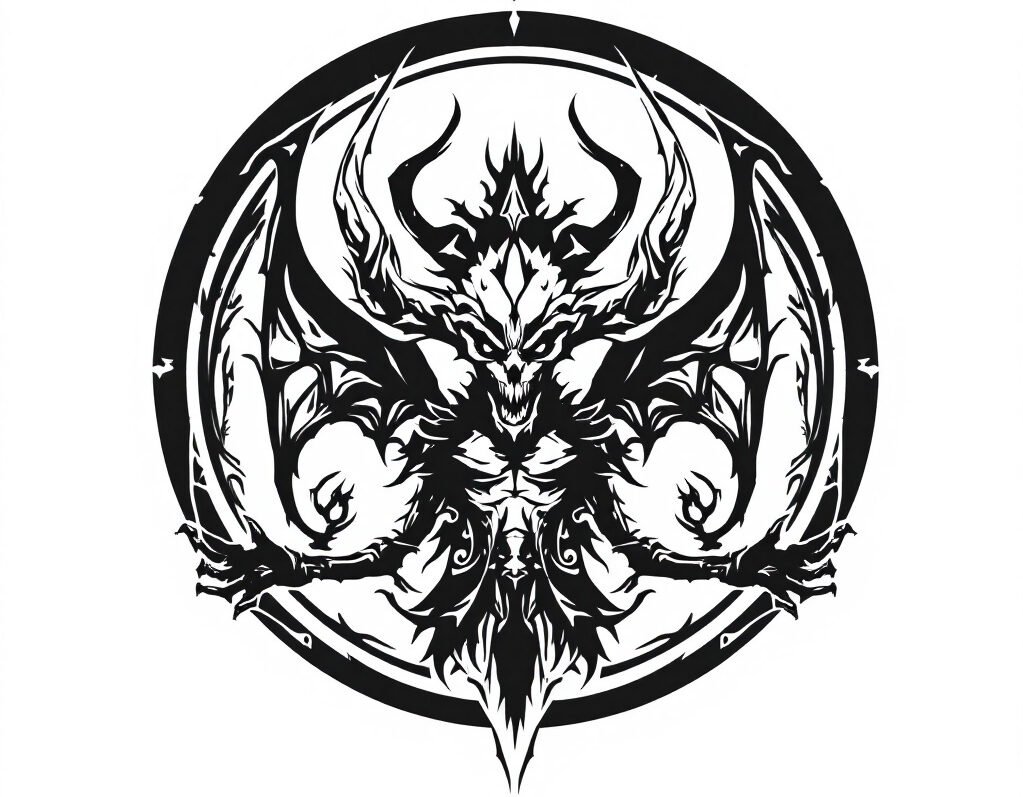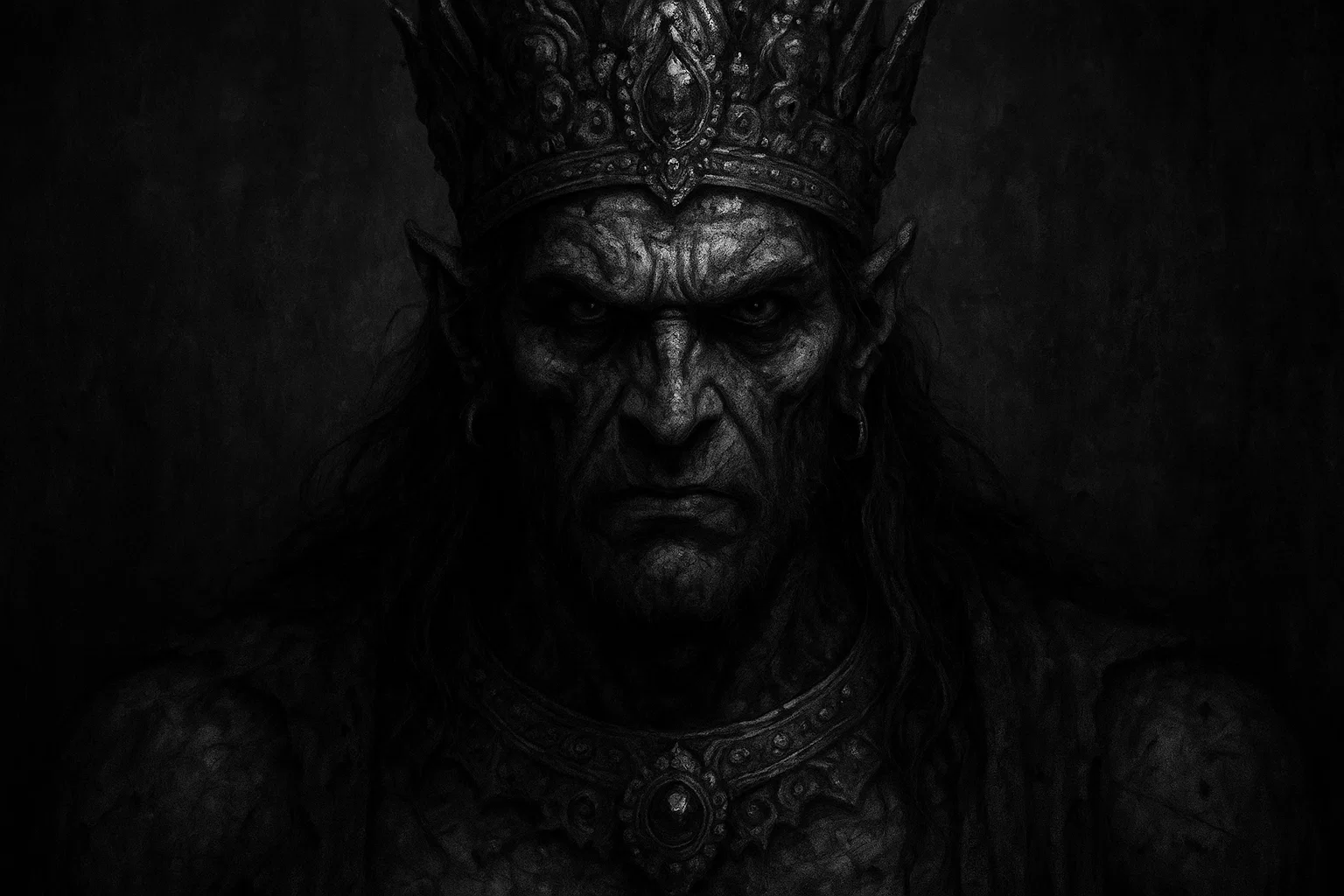Banasura is a strong Asura king from Hindu stories, known for ruling the city of Sonitapura. He is the son of the famous king Mahabali and a great-grandson of the devotee Prahlada.
As a key figure among the Daityas, Banasura stands out for his deep faith in Shiva and his immense power. Still, he also exhibits pride that leads to conflicts with the gods. His tale appears in important texts (like the Bhagavata Purana and the Mahabharata), where he plays the role of a tough enemy who gets humbled.
Although not as well-known as Ravana and some other asuras, Banasura is important in stories about the balance between good and evil. His life is marked by a mix of worship, war, and family drama, particularly through his daughter, Usha.
Summary
Key Takeaways
| Attribute | Details |
|---|---|
| Names | Banasura, Bana, Bāṇāsura. |
| Title | King of Sonitapura, Asura King. |
| Gender | Male. |
| Role | Conqueror, devotee of Shiva, guardian of his city, antagonist in cosmic battles; shows both destructive pride and heroic devotion. |
| Clan | Daitya. |
| Followers | His army commanders, soldiers, and son; also protected by Shiva’s forces like Nandi and Jvara. |
| Powers | Thousand arms for fighting and playing music, invincibility from Shiva’s boon, shape-shifting ability implied in battles, strong counterattacks with large armies. |
| Appearance | Shown with a thousand arms; after defeat, left with four arms; often pictured begging for mercy or in battle. |
| Etymology | From Sanskrit ‘bāṇa’ meaning arrow, and ‘asura’ meaning demon; suggests a sharp, powerful fighter. |
| Associated Figures | Shiva (protector), Krishna (opponent), Usha (daughter), Aniruddha (son-in-law), Mahabali (father), Prahlada (great-grandfather), Chitralekha (Usha’s friend), Narada. |
| Weaknesses | Pride and arrogance; extra arms severed by Krishna’s chakra; family promise from Vishnu spares his life but humbles him. |
| Opposing Deva/Avatar | Krishna (avatar of Vishnu). |
| Pantheon | Hindu, with roots in Puranic stories. |
| Primary Sources | Bhagavata Purana, Mahabharata, Harivamsa, Vishnu Purana, Tamil works like Manimekalai and Puranaanooru. |
“Banasura” Meaning
The name “Banasura” originates from ancient Sanskrit roots and holds profound significance in Hindu mythology.
“Bana” means “arrow” in Sanskrit, pointing to something sharp, fast, and deadly, like a weapon in battle. This fits Banasura’s role as a fierce warrior who fights with great skill and power.
The “asura” part means “demon” or a being opposed to the gods. However, in early texts, Asuras were not always evil—they were often depicted as strong spirits.
Over time, the word shifted to describe those who challenge the devas, or gods, often out of pride or desire for control.
Banasura’s meaning ties to his family line and actions. As the son of Mahabali (a well-known Asura king), Banasura inherits a legacy of strength and devotion.
Some stories link “bana” to his thousand arms (like many arrows shooting at once), showing his ability to handle multiple tasks or enemies. In Tamil texts, such as the Sangam works Manimekalai and Purananuru, his name appears in tales of rejected love for the goddess Shakti, adding depth to Banasura’s characterization as a bold yet flawed figure.
The etymology of Banasura also shows changes across regions and texts.
In the Bhagavata Purana, he’s called Banasura to highlight his demon side, especially when he turns cruel. However, in Kerala folklore, linked to his father, Mahabali, the name evokes respect, as Mahabali is revered in the region. This mix reflects how Asura names evolve—starting from simple words like “arrow” for power, then growing to represent complex characters in myths.
Variations of this powerful entity’s name include simply “Bana” in some stories, dropping the “asura” to focus on his human-like traits, such as being a loving father to Usha.
Overall, Banasura’s meaning goes beyond a label. It captures the tension between might and downfall. His name’s origins in Sanskrit point to ancient ideas of warriors as arrow-like—precise and unstoppable—yet vulnerable to greater forces.
In Hindu thought, such names remind us of life’s balance, where even the strongest can fall if pride takes over. This etymology helps explain why Banasura stands as a symbol of devotion mixed with ego, appearing in epics to teach lessons on humility.
How To Pronounce Banasura in English
Say it as “Bah-nah-soo-rah,” with stress on the first and third parts. The “a” sounds are like in “father,” and the “u” is like “oo” in “book.”
What Does Banasura Look Like?
In Hindu art and stories, Banasura appears as a giant with a thousand arms, making him both terrifying and awe-inspiring. With his thousand arms, this Asura of immense power can fight multiple foes simultaneously or accompany Shiva’s dance with music.
His body is strong and tall, like other Asura kings, with dark skin and fierce eyes that spark fear in kings and gods alike. He often wears royal attire (including jewels and armor) befitting his role as ruler of Sonitapura.
After his big fight with Krishna, pictures show him changed—left with just four arms, bowed low in defeat. This shift underlines his humbled state, from a proud warrior to one seeking mercy.
In some images, he’s on his knees before Krishna, with cut arms around him, bloodied but alive. His face might mix anger and regret, with long hair and a crown knocked askew.
Temples and folklore add details, such as in Assam, where sites link to his tale. There, he’s tied to hills and rivers. Still, visuals stay true to texts: a multi-armed demon devotee, blending human features with superhuman traits.
You may also enjoy:
Vaisravana: The Golden Guardian King Who Rules the North
October 16, 2025
Mara: The Buddhist Demon King of Desire and Death
October 13, 2025
Who Is Agares, the Demon of Earthquakes and Deception?
October 13, 2025
Who Is Taṇhā, the Seductive Demon of Craving in Buddhist Mythology?
October 15, 2025
Banasura: The Thousand-Armed Demon King
October 10, 2025
Who Is Jann in Islamic Mythology and Why Is He Feared?
October 2, 2025
Origins
Banasura’s story begins in the time of the great Asura kings, as the son of Mahabali, who was renowned for his generous nature and devotion to the gods. He rules over Sonitapura, a rich city where his power grows through worship of Shiva.
Early mentions of him appear in the Mahabharata. Still, his full tale unfolds in the Bhagavata Purana, portraying him as a blend of faithful servant and bold ruler. Over time, his legend spread to Tamil works and local folklore—such as in Kerala and Assam—where places bear his name.
His growth from a prince to a feared king occurs through hard work and the accumulation of boons. He becomes so strong that even gods shake before him, but this leads to his clash with Krishna.
His story develops in Puranic texts, focusing on themes of pride, family, and divine order. In Bhattavataar’s Banasura Katha and other later texts, he appears as a suitor for Shakti, adding romance to his warrior image.
Birth
Banasura was born to Bali (Mahabali), the great Asura king from the Daitya clan, in a time of cosmic struggles. Mahabali was a grandson of Prahlada and ruled with justice. However, Vishnu (as Vamana) humbled him by sending him to the underworld. Nevertheless, Mahabali’s line carried on with strong heirs like Banasura.
Little is said about Banasura’s early days, but as Mahabali’s son, he grew up in a world of Asura might and devotion.
Some sources—like the Bhagavata Purana—note his birth as part of the Prahlada family, known for their faith in Vishnu despite being asuras. Banasura learned warfare and worship at a young age, becoming a skilled fighter. His thousand arms might come from birth or a boon, marking him as special.
In folklore, Mahabali is strongly connected to certain places (like Kerala), suggesting Banasura’s roots there. He rises to rule Sonitapura, building a kingdom where his power shines. His early life sets the stage for his later acts—loyal to Shiva, yet bold enough to challenge the gods.
Family
Banasura’s family ties are rooted in a line of famous Asuras, beginning with his father, a king renowned for his generous heart and devotion to the gods.
Mahabali’s own story involves Vishnu’s Vamana avatar, but he passes on his strength to his son. Banasura’s mother is not named in the main texts, but his wife is Ambavati (Vrinda). They have a daughter, Usha, whose love story brings big changes.
Usha’s bond with her father is marked by a mix of care and strictness—he builds a fort to keep her safe, but this ultimately leads to conflict.
Banasura has a son who fights in battles, but no siblings are listed. His great-grandfather, Prahlada, influences him, as Krishna spares him due to this family link. Family plays a key role, from boons protecting kin to wars over love.
| Genealogy | Details |
|---|---|
| Parents | Father: Mahabali; Mother: None. |
| Siblings | None. |
| Spouse | Ambavati (Vrinda). |
| Children | Usha (daughter); a son. |
Asura-Deva Conflicts
Banasura plays a significant role in battles between Asuras and Devas, representing pride in opposition to divine order.
His main clash is with Krishna over his daughter Usha’s secret love for Aniruddha. When he traps Aniruddha, the Yadus launch an attack, triggering a massive war. However, his army, with 12 groups, fights hard, and Shiva joins to protect his devotee.
The battle shakes the cosmos—Krishna counters Shiva’s weapons, defeats fever spirits, and cuts Banasura’s arms. This fight upholds Dharma, as Banasura’s arrogance threatens to disrupt the balance of power.
Though beaten, he’s spared due to family ties, showing mercy in cosmic struggles. His role highlights how the Asuras test the gods, but Dharma ultimately wins, restoring peace.
Role in Hindu Cosmology
As a powerful king, he aligns with Hindu concepts of cycles, where beings rise and fall to maintain balance. As an Asura, he’s often seen as a villain for his cruelty and pride, but his deep devotion to Shiva adds shades—he’s an anti-hero who worships yet strays.
In the Bhagavata Purana, his story teaches that even strong faith can twist into ego, disrupting Dharma.
He influences divine affairs by challenging Krishna, compelling the gods to act. But his defeat reaffirms rebirth and order—spared, he bows, showing change is possible.
As Mahabali’s son and Prahlada’s kin, he links to themes of devotion across sides. His tale influences human stories, warning against overreach while honoring true worship.
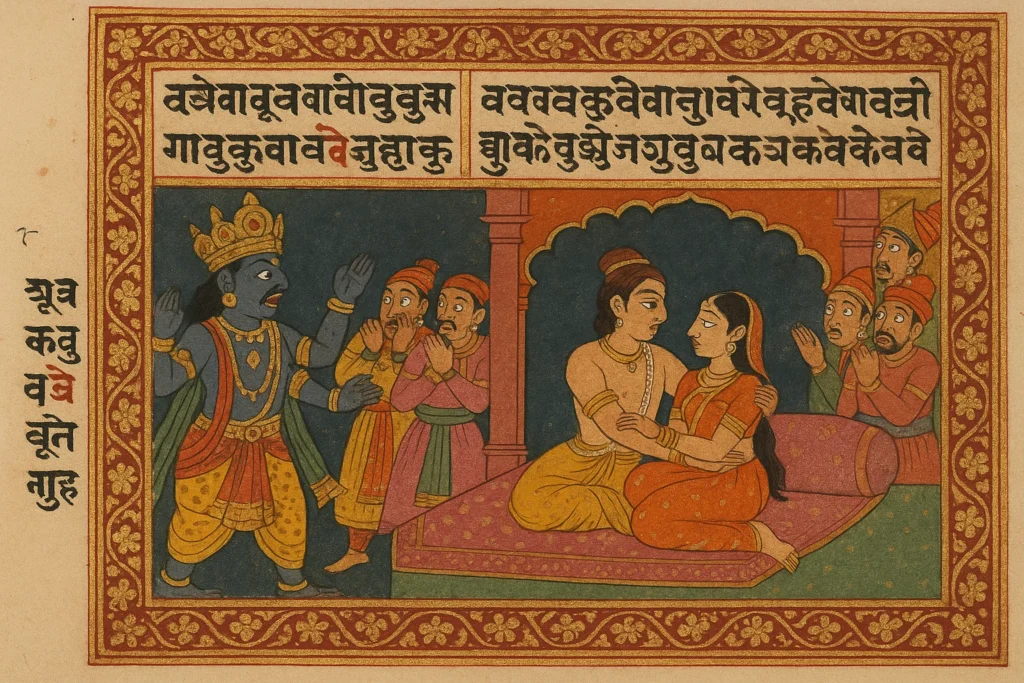
Was Banasura Ever Mentioned in Vedic Texts?
Banasura is not mentioned in the Rig Veda, the Atharva Veda, or any other Vedic texts. He likely comes from later epics and Puranas, where Asura stories grow to explain cosmic fights and devotion.
Banasura in Epics and Puranas
Banasura appears in the Mahabharata as a powerful king associated with Naraka’s tale, where his malevolent influence turns Naraka evil.
Valmiki’s epic mentions him briefly in family lines. In the Harivamsa, part of the Mahabharata, his war with Krishna gets detailed. The Vishnu Purana notes his line from Bali.
In the Bhagavata Purana, by Vyasa, he’s a key figure in Canto 10, Chapters 62-63, with epithets such as “thousand-armed devotee.” In Manimekalai and other Tamil texts, he is often mentioned as a suitor to Shakti.
| Source | Quote |
|---|---|
| Bhagavata Purana, Canto 10, Chapter 62 | “The princess named Ūṣā, a jewel among women, daughter of Bāṇa, once went with her girlfriends to the garden known as Kumārī-vana, which was consecrated to goddess Kātyāyanī and filled with golden-hued lotuses.” |
| Bhagavata Purana, Canto 10, Chapter 63 | “Lord Śiva, who has three eyes, at once caught sight of Lord Kṛṣṇa, enemy of Madhu. Taking up his bow, Śārṅga, he fixed upon it his arrow, which was none other than Lord Viṣṇu Himself.” |
| Mahabharata, Sabha Parva | “And, O king, that son of Jamadagni studying the Vedas, gratified his father, and devoted to the study of the Vedas was celebrated throughout the world. And he had a son celebrated over the three worlds viz., the illustrious Bana or Banasura endued with great prowess.” |
You may also enjoy:
Marid: The Ocean Jinn That Defies Heaven and Earth
September 30, 2025
What Is the Abumi-guchi Yōkai and Why Does It Wait Forever?
October 22, 2025
Who Is Taṇhā, the Seductive Demon of Craving in Buddhist Mythology?
October 15, 2025
Who Is Adrammelech in Demonology and the Bible?
October 1, 2025
Vritra: The Dragon Who Swallowed the Sky in Hindu Mythology
October 7, 2025
Who Was Abezethibou, the Fallen Angel Who Opposed Moses?
October 1, 2025
Powers and Abilities
Banasura’s power ranks high among Asuras (like Narakasura or Bali). Still, his thousand arms and Shiva’s boon make him unique—stronger than many but not unbeatable. He’s tougher than lesser demons but falls short against avatars.
- Thousand arms: Lets him fight multiple enemies or play music for Shiva.
- Invincibility boon: From Shiva, which makes him hard to defeat, guarding his city.
- Large army command: Leads 12 akshauhinis in battle.
- Weapon skills: Uses bows, chariots, and counters divine arms.
- Devotee protection: Calls on Shiva, Nandi, Kartikeya, and Jvara for aid.
- Shapeshifting: In fights, he adapts well, like most Asuras.
Banasura Myths, Legends, and Stories
The Story of Usha and Aniruddha
One fateful day, Usha, the cherished daughter of Banasura, found herself dreaming of a captivating young man. In her slumber, she felt an inexplicable bond forming between them, evoking a deep affection that bloomed within her heart.
Her close friend Chitralekha, a gifted painter with a keen eye for detail, recognized the turmoil in Usha’s heart and decided to assist her. With a flick of her brush, Chitralekha depicted various portraits of the Vrishnis, a noble clan. As the images unfolded, Usha’s heart skipped a beat—she realized that the handsome figure from her dreams was none other than Aniruddha, the valiant grandson of the revered Krishna.
Chitralekha, wielding her mystical powers, orchestrated a daring plan, transporting Aniruddha from his homeland in Dvaraka and bringing him to Sonitapura, the kingdom ruled by Banasura.
Upon his arrival, Usha lavished her beloved with exquisite gifts—opulent robes that shimmered like the evening stars, fragrant garlands of fresh flowers, aromatic perfumes that filled the air with intoxicating scents, flickering lamps that cast soft light, and a sumptuous feast that delighted the senses.
Their passion flourished in secrecy as she allowed the prince to stay hidden away in her private quarters, where the days melted into nights, and their love deepened beyond measure.
However, the blissful companionship did not remain concealed for long. Banasura, upon discovering the unusual sounds and laughter emanating from his daughter’s chamber, rushed in, only to find Usha and Aniruddha engaged in a leisurely game of dice, oblivious to the world around them.
In a furious confrontation, as Aniruddha bravely attempted to defend himself from Banasura’s guards, the formidable king swiftly ensnared him with the enchanted cords of Varuna, suppressing the prince’s valor.
Devastation washed over Usha like a tidal wave as her father captured the man she loved so dearly. Aniruddha was imprisoned within the stone walls of Banasura’s palace for an entire month, unbeknownst to the world outside.
Meanwhile, the news of Aniruddha’s plight traveled far and wide, eventually reaching the ears of Narada, the celestial sage, who promptly informed the Yadus in Dvaraka.
The Yadus, concerned for their brave kin, embarked on a rescue mission, determined to bring Aniruddha back from the clutches of Banasura and reunite the two star-crossed lovers with their stolen love.
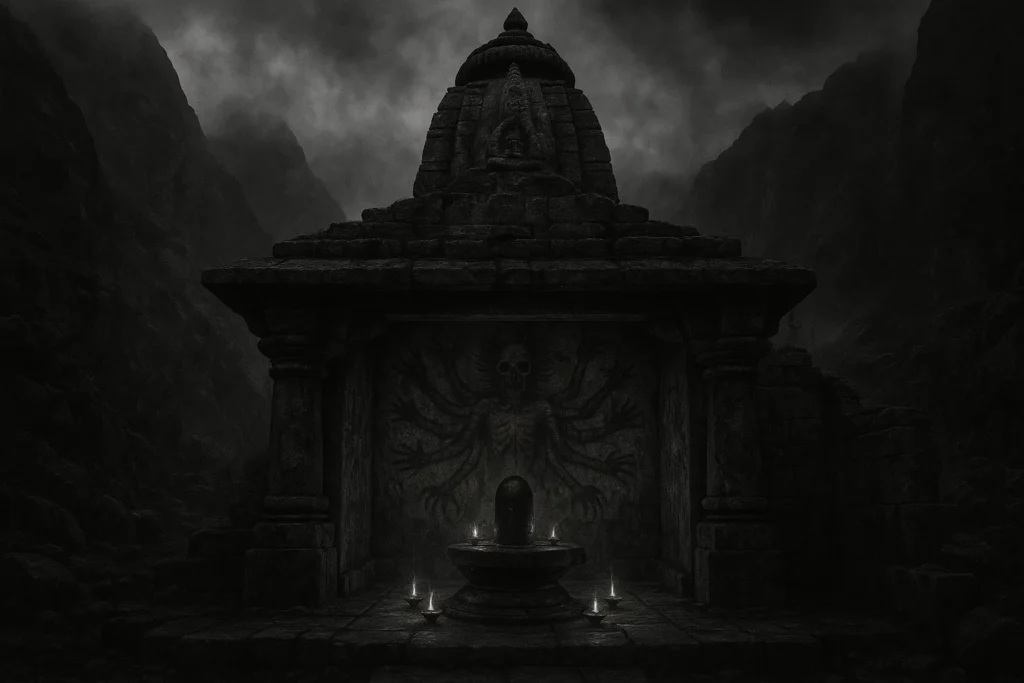
The War with Krishna
In a fierce battle, the forces of the Yadus launched an attack on Banasura, surrounding his kingdom with a large army. The mighty king fought back strongly, and during the conflict, Lord Shiva appeared on his sacred bull, Nandi, to protect him.
Balarama, one of the Yadu leaders, faced off against Banasura’s chief warrior, while Samba, another warrior, battled Banasura’s son. Meanwhile, divine beings, led by Brahma and accompanied by wise sages, celestial singers, and magical creatures, observed the battle from the skies.
Krishna, another key figure, encountered Shiva on the battlefield. The two exchanged powerful weapons; Krishna used a special weapon called a brahmastra against Shiva’s, as well as various other tools representing nature and forces.
Kartikeya, who faced Pradyumna, was forced to retreat after being hit. Banasura attempted to stand against Krishna with his own weapons. Still, Krishna blew his shell, which led to the defeat of Banasura’s charioteer and shattered his vehicle.
As the battle continued, a form of heat called Jvara, representing Shiva, attacked Krishna with intense heat. In response, Krishna created his own version of Jvara, which was icy cold, and the two engaged in a fierce struggle.
Eventually, Krishna’s chilly Jvara overwhelmed Shiva’s, and it surrendered to him. Krishna then used a special weapon called Jrmbhunastra to bring peace to the situation.
At the same time, Balarama managed to defeat Banasura’s leader. Riding into battle, Banasura confronted Krishna, who defended himself with his powerful Sudarshana Chakra. As Krishna began to cut off Banasura’s extra arms, Shiva regained his composure and praised Krishna, asking him to spare Banasura’s life.
Recognizing Banasura’s bravery and his connection to great heroes from the past, Krishna agreed. He didn’t intend to kill Banasura, who was the grandson of Bali, a great figure whom Vishnu had promised not to harm. Instead, Krishna decided to humble Banasura by removing some of his extra arms, leaving him with four.
Realizing his mistakes, Banasura recognized Krishna’s power and lowered his head in respect. In a gesture of goodwill, he prepared a chariot to take Aniruddha and Usha, a couple, to their wedding in the city of Dvaraka.
Banasura vs Other Asuras
| Asura Name | Associated Trait/Role | Clan/Origin | Key Traits/Powers |
|---|---|---|---|
| Ravana | Conquest | Rakshasa, Ramayana | Boons from Brahma, ten heads, shape-shifting. |
| Hiranyakashipu | Tyranny | Daitya, Bhagavata Purana | Invincibility boon, lion-man opposition. |
| Narakasura | Oppression | Asura, Mahabharata | Earth control, slain by Krishna. |
| Mahabali | Generosity | Daitya, Vishnu Purana | Devotion, humbled by Vamana. |
| Vritra | Drought | Asura, Rig Veda | Water blocking, slain by Indra. |
| Andhaka | Blindness | Asura, Shiva Purana | Regeneration, thousand clones. |
| Shumbha | Pride | Asura, Devi Mahatmya | Shape-shifting, slain by Durga. |
| Nishumbha | Greed | Asura, Devi Mahatmya | Warrior skills, Durga’s foe. |
| Raktabija | Multiplication | Asura, Devi Mahatmya | Blood cloning, slain by Kali. |
| Madhu | Deception | Daitya, Mahabharata | Illusion, slain by Vishnu. |
| Kaitabha | Fear | Daitya, Mahabharata | Strength, slain by Vishnu. |
| Tarakasura | Invincibility | Asura, Skanda Purana | Boon against gods, slain by Kartikeya. |
| Hiranyaksha | Earth sinking | Daitya, Bhagavata Purana | Boar avatar opposition. |
| Prahlada | Devotion | Daitya, Bhagavata Purana | Faith in Vishnu, spared. |
| Bali | Sacrifice | Daitya, Vishnu Purana | Charity, underworld rule. |
Rank Among Asuras
Banasura holds a high spot in the Daitya clan as Mahabali’s son and Prahlada’s great-grandson, making him part of a respected line.
He rules Sonitapura as a leader, commanding big armies and earning Shiva’s guard duty. This sets him above many asuras, like lesser demons in stories, but below top ones like Hiranyakashipu in raw might.
His ties with other Asuras show both help and sway—he influences Naraka to turn bad, linking their fates. Rivalries with Devas reach their peak in his war with Krishna, where even Shiva’s aid proves insufficient.
As a Daitya leader, he stands for Asura pride, but his defeat humbles the clan, reinforcing deva rule.
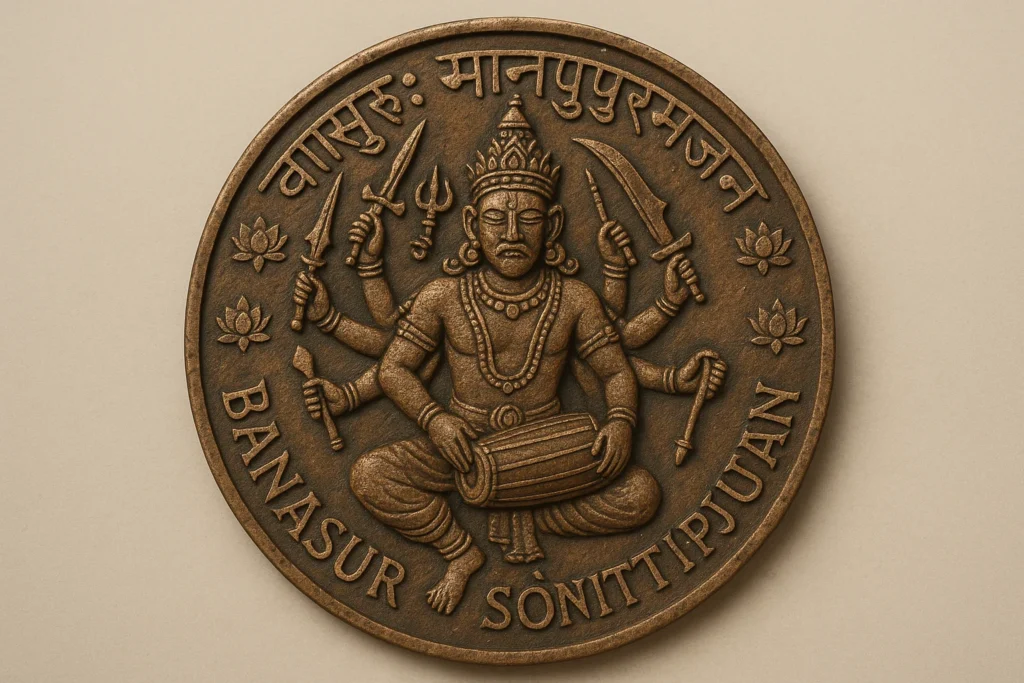
Mystical Correspondences
| Attribute | Details |
|---|---|
| Planet | Mars. |
| Zodiac Sign | Aries. |
| Element | Fire. |
| Direction | South. |
| Color | Red. |
| Number | 1000. |
| Crystal/Mineral | Ruby. |
| Metal | Iron. |
| Herb/Plant | Red chili. |
| Animal | Bull. |
| Trait/Role | Warfare, devotion. |
Banasura is a powerful figure whose connection to the stars shapes his character and abilities. He is ruled by Mars, the planet symbolizing war and determination. This influence gives him incredible strength in battles, especially against the gods.
Rituals to invoke his power often take place on Tuesdays or during the month of Aries (from March 21 to April 19), which are times when his energy is believed to be strongest.
As an Aries, Banasura possesses a fiery spirit that drives his relentless pursuit of dominance over Sonitapura and beyond. His astrological connection enhances his fighting skills, as illustrated in ancient stories where his chariot soars through the sky, challenging divine beings.
Banasura’s connection to fire showcases his passionate and fierce nature. In various tales, his anger can ignite like flames, and his many arms radiate strength and magical energy. Fire is also significant in Vedic beliefs, representing transformation and power, which aligns with Banasura’s rule over his city, said to sparkle with vitality.
He uses fire in his worship of Shiva, sending forth vibrant energy that strengthens his abilities. His fiery nature is evident in his fierce battles, where he moves with the speed and intensity of a blazing fire, demonstrating his mastery over both land and the skies.
These qualities reveal the essence of Banasura—destructive yet loyal. His power is often symbolized by the color red, representing both strength and the blood shed in battle.
The number 1,000 signifies his immense strength, while gems like rubies enhance his force in rituals.
Metals like iron are suitable for his weapons, and plants like red chili add zest to life, while animals like the bull, exemplified by Nandi, embody his might.
Banasura’s Symbols
Banasura’s signs include the Rasalingam he worships, a holy item from Vishvakarman, created by Vishnu’s word. His thousand arms symbolize multi-tasking power, used for the mridangam in Shiva’s dance.
After he was defeated, the remaining four arms mark humility. The mridangam itself is a key sign, linking to his devotion. His chariot and cut arms in art show the fall of pride.
Worship and Boons
Banasura honors Shiva with deep rituals, such as playing the mridangam during tandavam and tending to the rasalingam. His tapasya, or hard penance, wins Shiva’s favor. Pleased, Shiva grants a boon: to guard Sonitapura, making Banasura hard to beat. This gift also brings fearlessness, letting him grow bold.
But this leads to trouble. Gods approach Vishnu, as Banasura harms the world. Krishna, as Vishnu’s form, fights him, since the boon covers most but not all.
Temples like Mahabhairav in Assam are linked to his worship, with Shiva lingams he sets up. In Kerala, sites honor his Mahabali tie. His story warns that boons from tapasya need wise use, or they bring downfall.
You may also enjoy:
Vritra: The Dragon Who Swallowed the Sky in Hindu Mythology
October 7, 2025
Who Was Ravana in Hindu Mythology and Why Was He Feared?
October 3, 2025
Aamon: The Infernal Marquis of Lust, Feuds, and False Prophecies
September 29, 2025
Agubanba: The Ash-Born Demon of Japanese Folklore
October 23, 2025
Marid: The Ocean Jinn That Defies Heaven and Earth
September 30, 2025
Rāga: The Seductive Demon of Passion and Desire in Buddhist Lore
October 16, 2025
